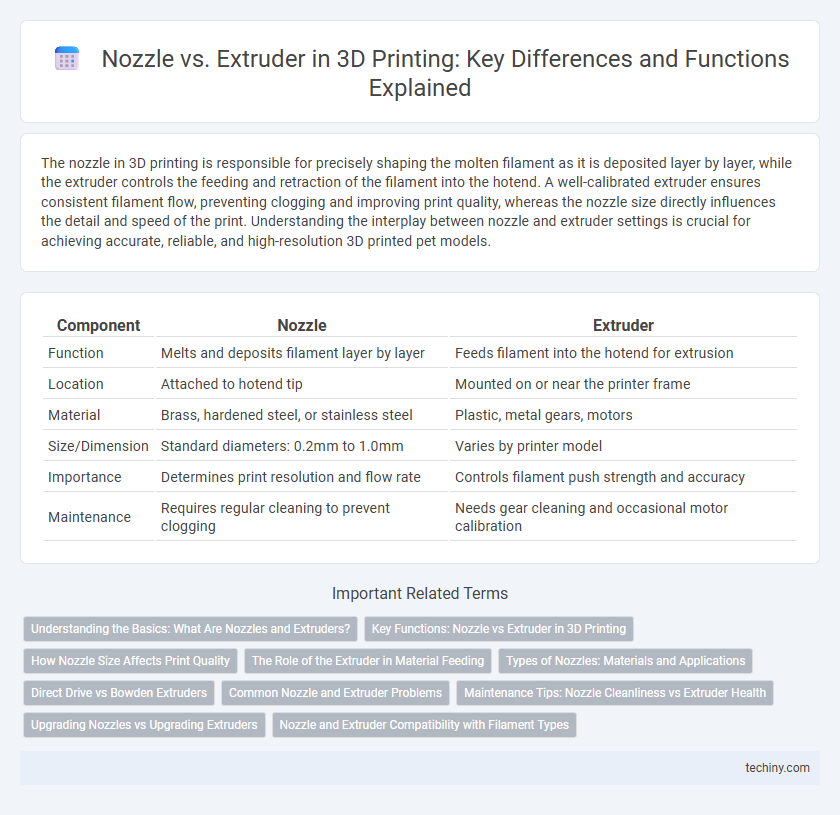The nozzle in 3D printing is responsible for precisely shaping the molten filament as it is deposited layer by layer, while the extruder controls the feeding and retraction of the filament into the hotend. A well-calibrated extruder ensures consistent filament flow, preventing clogging and improving print quality, whereas the nozzle size directly influences the detail and speed of the print. Understanding the interplay between nozzle and extruder settings is crucial for achieving accurate, reliable, and high-resolution 3D printed pet models.
Table of Comparison
| Component | Nozzle | Extruder |
|---|---|---|
| Function | Melts and deposits filament layer by layer | Feeds filament into the hotend for extrusion |
| Location | Attached to hotend tip | Mounted on or near the printer frame |
| Material | Brass, hardened steel, or stainless steel | Plastic, metal gears, motors |
| Size/Dimension | Standard diameters: 0.2mm to 1.0mm | Varies by printer model |
| Importance | Determines print resolution and flow rate | Controls filament push strength and accuracy |
| Maintenance | Requires regular cleaning to prevent clogging | Needs gear cleaning and occasional motor calibration |
Understanding the Basics: What Are Nozzles and Extruders?
Nozzles and extruders are essential components in 3D printing that work together to shape the printed object. The extruder is responsible for feeding and melting the filament, while the nozzle controls the flow and precision of the molten material onto the print bed. Understanding the interplay between nozzle size and extruder type is crucial for achieving optimal print quality and resolution.
Key Functions: Nozzle vs Extruder in 3D Printing
The nozzle in 3D printing is responsible for precisely depositing melted filament onto the build platform, controlling print resolution and layer thickness. The extruder drives the filament into the hotend, regulating the flow rate and pressure to ensure consistent material delivery. Together, the nozzle and extruder coordinate to achieve accurate material extrusion, directly impacting print quality and finish.
How Nozzle Size Affects Print Quality
Nozzle size directly influences print resolution and detail precision in 3D printing, with smaller nozzles delivering finer layers and sharper features ideal for intricate models. Larger nozzles increase filament flow, reducing print time but sacrificing detail and surface smoothness, resulting in coarser textures. Selecting the appropriate nozzle size balances print speed and quality based on project requirements and material characteristics.
The Role of the Extruder in Material Feeding
The extruder in 3D printing is responsible for feeding the filament material consistently into the hotend, where the nozzle melts and deposits it layer by layer. It controls the flow rate and pressure of the filament, ensuring precise and smooth extrusion for accurate print quality. Proper extruder calibration directly influences the efficiency of material feeding and the final output of the printed object.
Types of Nozzles: Materials and Applications
Nozzles in 3D printing are commonly made from brass, stainless steel, or hardened steel, each material offering distinct advantages for different applications. Brass nozzles provide excellent thermal conductivity and are ideal for standard filaments like PLA and ABS, while stainless steel nozzles resist corrosion and are suitable for food-safe or medical-grade printing. Hardened steel nozzles are designed to print abrasive materials such as carbon fiber or glow-in-the-dark filaments, ensuring durability and longevity in demanding printing environments.
Direct Drive vs Bowden Extruders
Direct drive extruders position the motor directly on the hotend, providing precise filament control ideal for flexible materials, while Bowden extruders separate the motor from the hotend via a long PTFE tube, reducing the moving mass for faster print speeds and improved accuracy. Direct drive systems excel in handling flexible and specialty filaments due to minimal filament path length, whereas Bowden setups enhance printer speed and reduce vibrations but may struggle with flexible filament feeding. Choosing between direct drive and Bowden extruders depends on print material requirements, desired speed, and printer design constraints.
Common Nozzle and Extruder Problems
Common nozzle problems in 3D printing include clogging, wear, and inconsistent extrusion, which can lead to poor print quality and layer adhesion issues. Extruder issues often involve gear slippage, filament grinding, and inadequate tension, causing under-extrusion or filament jams. Regular maintenance, proper temperature settings, and quality filament can minimize these common nozzle and extruder problems, ensuring smoother printing performance.
Maintenance Tips: Nozzle Cleanliness vs Extruder Health
Maintaining nozzle cleanliness ensures consistent filament flow and high-quality prints by preventing clogs and buildup of residue. Extruder health relies on regular inspection of gears and proper tension adjustment to avoid filament slippage and ensure smooth feeding. Both nozzle and extruder maintenance are critical for minimizing print defects and prolonging the lifespan of 3D printer components.
Upgrading Nozzles vs Upgrading Extruders
Upgrading nozzles in 3D printing enhances print resolution and material flow precision by allowing finer layer deposition and compatibility with diverse filament types, leading to improved surface details and reduced clogs. Upgrading extruders focuses on boosting filament feed consistency, enabling the use of flexible, abrasive, or specialty filaments with fewer jams and increased reliability at higher printing speeds. Selecting between nozzle and extruder upgrades depends on the desired print quality improvements and material versatility, with nozzles optimizing detail and extruders enhancing extrusion control.
Nozzle and Extruder Compatibility with Filament Types
Nozzle and extruder compatibility with filament types is crucial for optimal 3D printing performance, as different materials require specific temperature ranges and nozzle diameters to ensure proper extrusion and adhesion. For example, flexible filaments like TPU perform better with a direct drive extruder and larger nozzle openings, while abrasive materials such as carbon fiber composites demand hardened steel nozzles to resist wear. Matching the extruder type and nozzle material to the filament ensures consistent flow, reduces clogs, and enhances print quality across various thermoplastics like PLA, ABS, PETG, and specialty composites.
Nozzle vs Extruder Infographic

 techiny.com
techiny.com